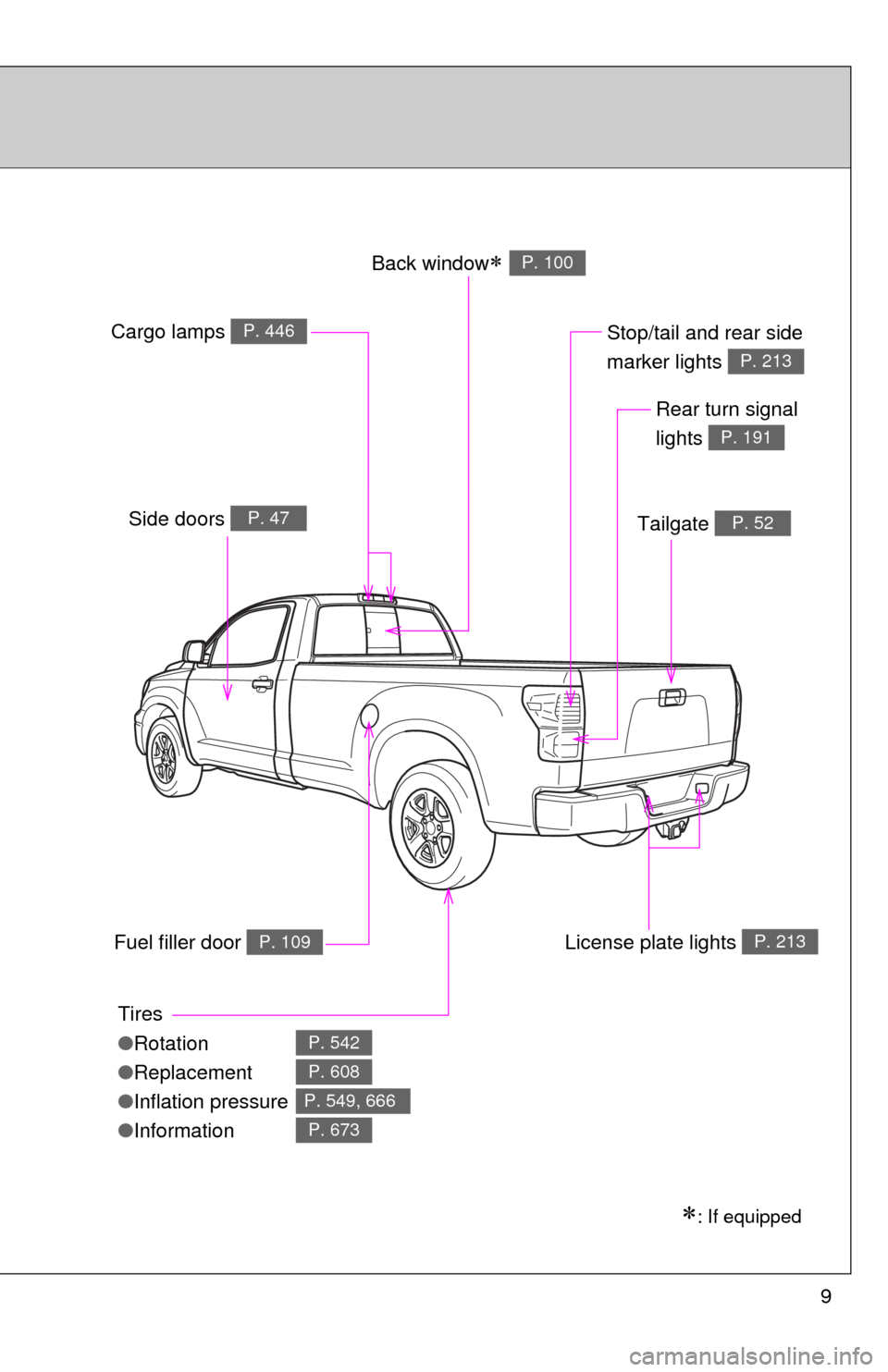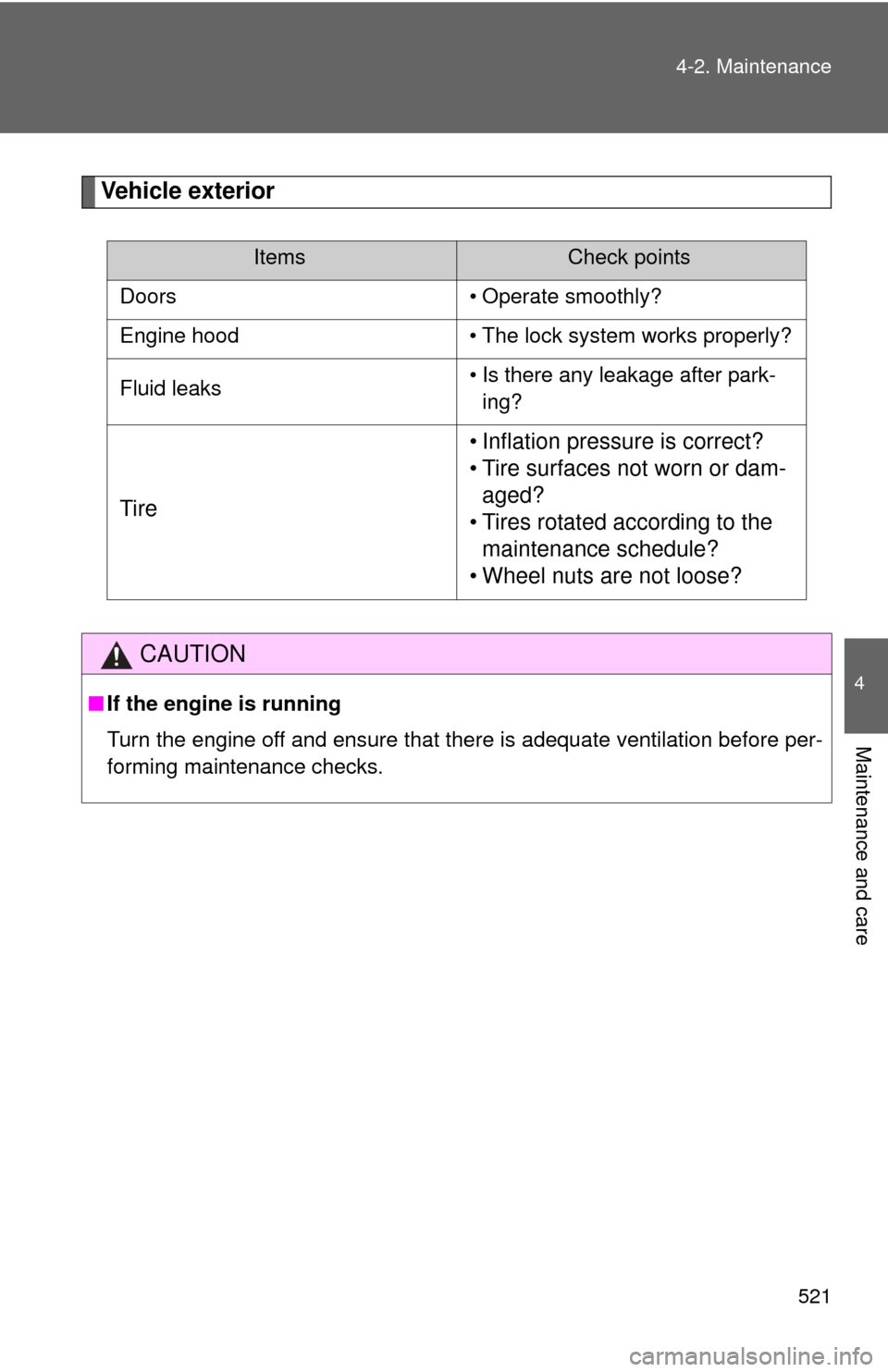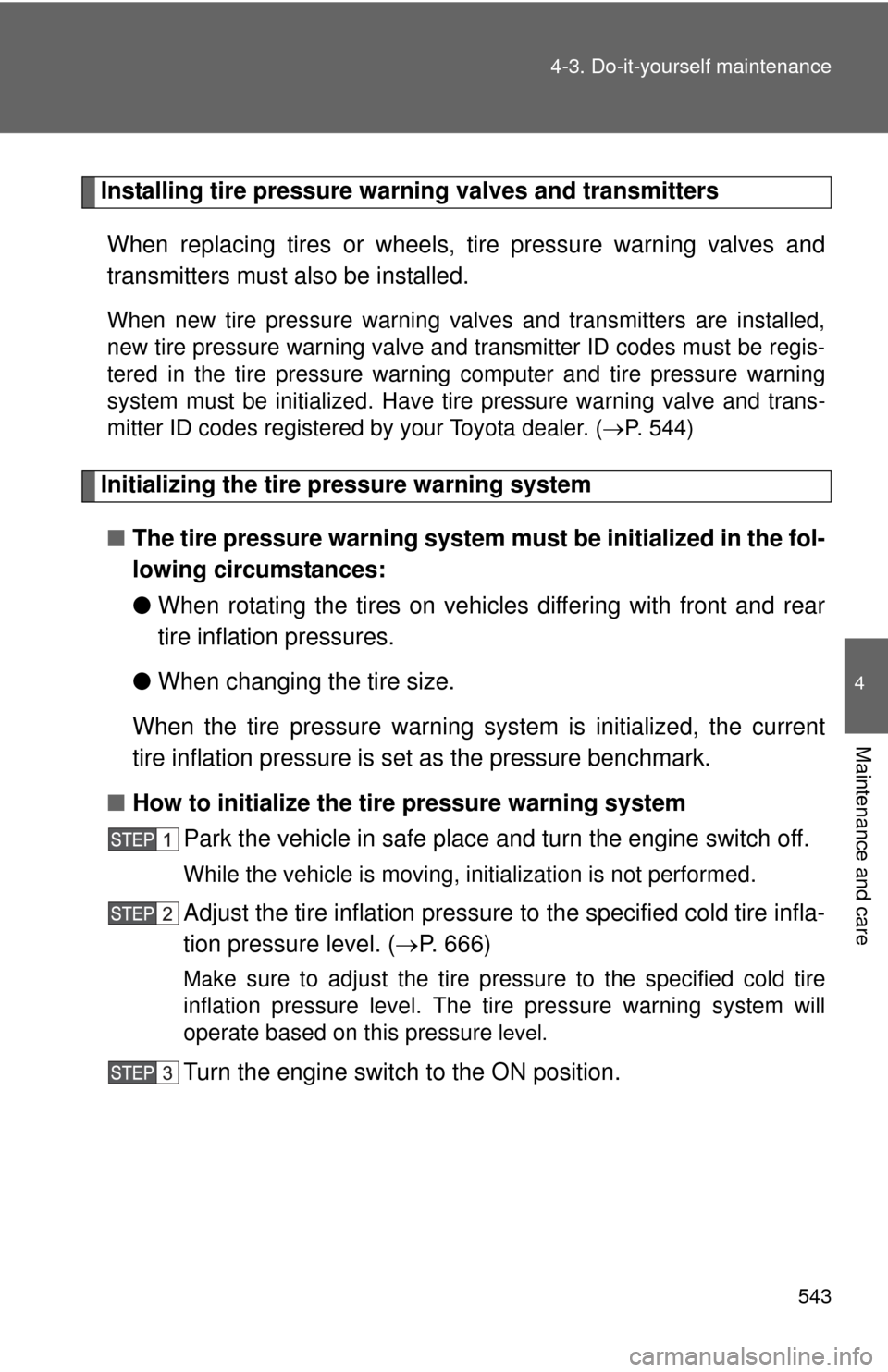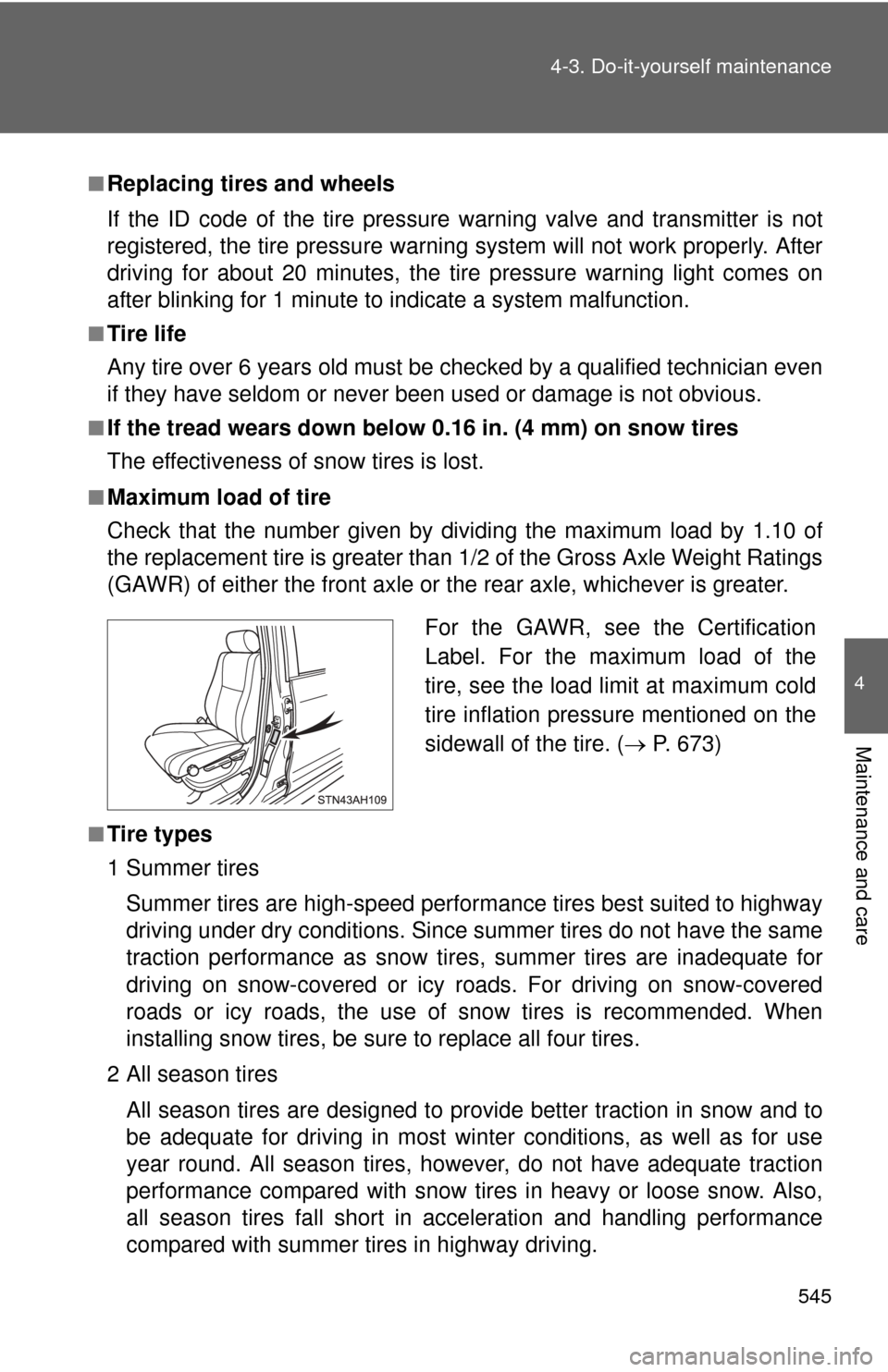inflation pressure TOYOTA TUNDRA 2010 2.G Owners Manual
[x] Cancel search | Manufacturer: TOYOTA, Model Year: 2010, Model line: TUNDRA, Model: TOYOTA TUNDRA 2010 2.GPages: 724, PDF Size: 13.74 MB
Page 5 of 724

1
2
3
4
5
6
7
5
4-1. Maintenance and careCleaning and protecting the vehicle exterior............ 512
Cleaning and protecting the vehicle interior............. 514
4-2. Maintenance Maintenance requirements ..................... 517
General maintenance.......... 519
Emission inspection and maintenance (I/M)
programs........................... 522
4-3. Do-it-yourself maintenance Do-it-yourself service precautions ....................... 523
Hood ................................... 527
Engine compartment ........... 528
Tires .................................... 542
Tire inflation pressure ......... 549
Wheels ................................ 553
Air conditioning filter............ 555
Wireless remote control battery ............................... 558
Checking and replacing fuses ................................. 560
Light bulbs........................... 571 5-1. Essential information
Emergency flashers............ 584
If your vehicle needs to be towed................................ 585
If you think something is wrong ............................... 591
Fuel pump shut off system .............................. 592
Event data recorder ............ 593
5-2. Steps to take in an emergency If a warning light turns on or a warning buzzer
sounds... .......................... 595
If a warning message is displayed (vehicles
with multi-information
display) ............................. 604
If you have a flat tire ........... 608
If the engine will not start.... 625
If the shift lever cannot be shifted from P ................... 627
If you lose your keys........... 630
If the vehicle battery is discharged........................ 631
If your vehicle overheats .... 634
If the vehicle becomes stuck ................................. 637
If your vehicle has to be stopped in an
emergency ........................ 638
4Maintenance and care5When trouble arises
Page 9 of 724

9
Tires
●Rotation
● Replacement
● Inflation pressure
● Information
P. 542
P. 608
P. 549, 666
P. 673
Fuel filler door P. 109
Back windowP. 100
Side doors P. 47
: If equipped
Tailgate P. 52
License plate lights P. 213
Stop/tail and rear side
marker lights
P. 213
Rear turn signal
lights
P. 191
Cargo lamps P. 446
Page 11 of 724

11
Tires
●Rotation
● Replacement
● Inflation pressure
● Information
P. 542
P. 608
P. 549, 666
P. 673
Fuel filler door P. 109
Back window
Power back window
P. 100
P. 101
Side doors P. 47
: If equipped
Tailgate P. 52
License plate lights P. 213
Rear turn signal
lights
P. 191
Cargo lamps P. 446Stop/tail and rear side
marker lights
P. 213
Page 13 of 724

13
Tires
●Rotation
● Replacement
● Inflation pressure
● Information
P. 542
P. 608
P. 549, 666
P. 673
Fuel filler door P. 109
Power back windowP. 101
Side doors P. 47
: If equipped
Tailgate P. 52
License plate lights P. 213
Rear turn signal
lights
P. 191
Cargo lamps P. 446Stop/tail and rear side
marker lights
P. 213
Page 511 of 724

Maintenance and care4
511
4-1. Maintenance and careCleaning and protecting the vehicle exterior ......... 512
Cleaning and protecting the vehicle interior .......... 514
4-2. Maintenance Maintenance requirements .................. 517
General maintenance....... 519
Emission inspection and maintenance (I/M)
programs........................ 522
4-3. Do-it-yourself maintenance Do-it-yourself service precautions .................... 523
Hood ................................ 527
Engine compartment ........ 528
Tires ................................. 542
Tire inflation pressure ...... 549
Wheels ............................. 553
Air conditioning filter......... 555
Wireless remote control battery ............................ 558
Checking and replacing fuses .............................. 560
Light bulbs........................ 571
Page 521 of 724

521
4-2. Maintenance
4
Maintenance and care
Vehicle exterior
ItemsCheck points
Doors • Operate smoothly?
Engine hood • The lock system works properly?
Fluid leaks • Is there any leakage after park-
ing?
Tire • Inflation pressure is correct?
• Tire surfaces not worn or dam-
aged?
• Tires rotated according to the maintenance schedule?
• Wheel nuts are not loose?
CAUTION
■ If the engine is running
Turn the engine off and ensure that there is adequate ventilation before per-
forming maintenance checks.
Page 524 of 724

524 4-3. Do-it-yourself maintenance
ItemsParts and tools
Light bulbs ( P. 571)• Bulb with same number and watt-
age rating as original
• Phillips-head screwdriver
• Flathead screwdriver
Power steering fluid level (P. 537) • Automatic transmission fluid
DEXRON
® II or III
• Rag or paper towel
Radiator and condenser (P. 535)
Tire inflation pressure (
P. 549) • Tire pressure gauge
• Compressed air source
Washer fluid
(P. 540) • Water
• Washer fluid containing antifreeze
(for winter use)
Page 542 of 724

542
4-3. Do-it-yourself maintenance
Tires
Replace or rotate tires in accordance with maintenance sched-
ules and treadwear.
■Checking tires
New tread
Treadwear indicator
Worn tread
The location of treadwear
indicators is shown by the
“TWI” or “ ” marks, etc.,
molded on the sidewall of
each tire.
Check spare tire condition
and inflation pressure if not
rotated.
■Tire rotation
Rotate the tires in the order
shown.
To equalize tire wear and
extend tire life, Toyota recom-
mends that tire rotation is
carried out at the same inter-
val as tire inspection.
Do not fail to initialize the tire
pressure warning system
after tire rotation.
■The tire pressure warning system
Your Toyota is equipped with a tire pressure warning system that
uses tire pressure warning valves and transmitters to detect low
tire inflation pressure before serious problems arise. (P. 598)
Front
Page 543 of 724

543
4-3. Do-it-yourself maintenance
4
Maintenance and care
Installing tire pressure warning valves and transmitters
When replacing tires or wheels, tire pressure warning valves and
transmitters must also be installed.
When new tire pressure warning valves and transmitters are installed,
new tire pressure warning valve and transmitter ID codes must be regis-
tered in the tire pressure warning computer and tire pressure warning
system must be initialized. Have tire pressure warning valve and trans-
mitter ID codes registered by your Toyota dealer. ( P. 544)
Initializing the tire pressure warning system
■ The tire pressure warning system must be initialized in the fol-
lowing circumstances:
●When rotating the tires on vehicles differing with front and rear
tire inflation pressures.
● When changing the tire size.
When the tire pressure warning system is initialized, the current
tire inflation pressure is set as the pressure benchmark.
■ How to initialize the tire pressure warning system
Park the vehicle in safe place and turn the engine switch off.
While the vehicle is moving, in itialization is not performed.
Adjust the tire inflation pressure to the specified cold tire infla-
tion pressure level. ( P. 666)
Make sure to adjust the tire pressure to the specified cold tire
inflation pressure level. The ti re pressure warning system will
operate based on this pressure
level.
Turn the engine switch to the ON position.
Page 545 of 724

545
4-3. Do-it-yourself maintenance
4
Maintenance and care
■Replacing tires and wheels
If the ID code of the tire pressure warning valve and transmitter is not
registered, the tire pre
ssure warning system will not work properly. After
driving for about 20 minutes, the ti re pressure warning light comes on
after blinking for 1 minute to indicate a system malfunction.
■Tire life
Any tire over 6 years old must be checked by a qualified technician even
if they have seldom or never been used or damage is not obvious.
■If the tread wears down below 0.16 in. (4 mm) on snow tires
The effectiveness of snow tires is lost.
■Maximum load of tire
Check that the number given by divi ding the maximum load by 1.10 of
the replacement tire is greater than 1/2 of the Gross Axle Weight Ratings
(GAWR) of either the front axle or the rear axle, whichever is greater.
■Tire types
1 Summer tires
Summer tires are high-speed performance tires best suited to highway
driving under dry conditions. Since summer tires do not have the same
traction performance as snow tire s, summer tires are inadequate for
driving on snow-covered or icy roads. For driving on snow-covered
roads or icy roads, the use of snow tires is recommended. When
installing snow tires, be sure to replace all four tires.
2 All season tires All season tires are designed to provide better traction in snow and to
be adequate for driving in most winter conditions, as well as for use
year round. All season tires, however, do not have adequate traction
performance compared with snow tires in heavy or loose snow. Also,
all season tires fall short in acceleration and handling performance
compared with summer tires in highway driving.
For the GAWR, see the Certification
Label. For the maximum load of the
tire, see the load limit at maximum cold
tire inflation pressure mentioned on the
sidewall of the tire. ( P. 673)